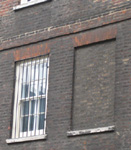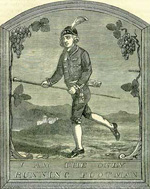Okay, not death. But let’s talk about taxes since most of us in the U.S. are getting pretty near the deadline for submitting our annual tax returns.
While we’re never happy about paying taxes, I thought it might be a good time to think about the taxes we’re not paying that our heroes and heroines probably faced during the Regency.
 One of the most widely known taxes during our period was the window tax. The window tax was introduced in 1691 and lasted until 1851. That’s a lot of windows. The tax was imposed upon every inhabited dwelling house in England (and Wales), except cottages. That is, houses not paying to church and poor rates in a parish. By 1792, the rates ran from 6 shillings and 6 pence for houses with six windows or less to houses with 180 windows or more for which the charge was 93 pounds 2 shillings and 6 pence, with 3 shillings charged for every window over that number. As you might imagine, this led to a lot of bricked-up windows.
One of the most widely known taxes during our period was the window tax. The window tax was introduced in 1691 and lasted until 1851. That’s a lot of windows. The tax was imposed upon every inhabited dwelling house in England (and Wales), except cottages. That is, houses not paying to church and poor rates in a parish. By 1792, the rates ran from 6 shillings and 6 pence for houses with six windows or less to houses with 180 windows or more for which the charge was 93 pounds 2 shillings and 6 pence, with 3 shillings charged for every window over that number. As you might imagine, this led to a lot of bricked-up windows.
Another interesting tax – and one we don’t have to worry about – is  the tax on hair powder, introduced in 1795. After May 5 of that year, very person in Great Britain using hair-powder was required to enter his name at one of the stamp offices and to take out an annual certificate which proved he had paid the tax of one guinea (One pound plus one shilling). exemptions to the tax included the royal family and their servants; clergymen with an income under £100 a year, officers in the navy under the rank of commander, subalterns, non-commissioned officers, and privates in the army, artillery, militia, marines, engineers, and fencibles. Exemptions were also made for families with large number of ladies. A father with two or more unmarried daughters could obtain a certificate for any numbers of hair-powder users in his household, provided he paid for the use of the powder by two people. The government hoped that the tax would raise a revenue of £200,000 per year. Instead, people stopped powdering their hair and, in the first year, it raised only £210.136.
the tax on hair powder, introduced in 1795. After May 5 of that year, very person in Great Britain using hair-powder was required to enter his name at one of the stamp offices and to take out an annual certificate which proved he had paid the tax of one guinea (One pound plus one shilling). exemptions to the tax included the royal family and their servants; clergymen with an income under £100 a year, officers in the navy under the rank of commander, subalterns, non-commissioned officers, and privates in the army, artillery, militia, marines, engineers, and fencibles. Exemptions were also made for families with large number of ladies. A father with two or more unmarried daughters could obtain a certificate for any numbers of hair-powder users in his household, provided he paid for the use of the powder by two people. The government hoped that the tax would raise a revenue of £200,000 per year. Instead, people stopped powdering their hair and, in the first year, it raised only £210.136.
 The tax on “establishments of horses ” was introduced in 1784. It exempted, at first, horses used for agricultural purposes and was imposed only upon “pleasure horses kept for amusement.” For every horse kept and used “for the saddle” or for “driving in a carriage” (which again, another taxable item) a tax of 10 shillings per year was levied. 1805 the taxation had been increased considerably. For one horse kept for pleasure the tax imposed was 2 pounds 17 shillings and 6 pence. For two horses, 4 pounds,14 shillings and 6 pence (that is 9 pounds 9 shillings for two), and so on along a sliding scale to an establishment of 20 or more horses where a tax of 6 pounds and 12 shillings was charged for every saddle or carriage horse. The result of this was not that people stopped keeping pleasure horses but that, frequently, they rode horses meant for agricultural purposes. See, for example, Mrs. Bennet co-opting Mr. Bennet’s farm horse to send Jane to Netherfield in the rain in Pride & Prejudice.
The tax on “establishments of horses ” was introduced in 1784. It exempted, at first, horses used for agricultural purposes and was imposed only upon “pleasure horses kept for amusement.” For every horse kept and used “for the saddle” or for “driving in a carriage” (which again, another taxable item) a tax of 10 shillings per year was levied. 1805 the taxation had been increased considerably. For one horse kept for pleasure the tax imposed was 2 pounds 17 shillings and 6 pence. For two horses, 4 pounds,14 shillings and 6 pence (that is 9 pounds 9 shillings for two), and so on along a sliding scale to an establishment of 20 or more horses where a tax of 6 pounds and 12 shillings was charged for every saddle or carriage horse. The result of this was not that people stopped keeping pleasure horses but that, frequently, they rode horses meant for agricultural purposes. See, for example, Mrs. Bennet co-opting Mr. Bennet’s farm horse to send Jane to Netherfield in the rain in Pride & Prejudice.
 In 1777, an annual tax of a guinea per man was imposed on male servants. According to Pamela Horne in The Complete Servant, “Although originally intended to help finance the war of American Independence, it was retained in modified form until 1937. In addition between 1795 and 1869 a tax on hair powder was levied and this, too, added to the cost of employing footmen and coachmen in full regalia.”
In 1777, an annual tax of a guinea per man was imposed on male servants. According to Pamela Horne in The Complete Servant, “Although originally intended to help finance the war of American Independence, it was retained in modified form until 1937. In addition between 1795 and 1869 a tax on hair powder was levied and this, too, added to the cost of employing footmen and coachmen in full regalia.”
These are just a sample of the taxes in existence during our period. You might also like to investigate the tax on the home consumption of pepper. Or how about raisins? Or the tax levied from 1784 to 1811 on men’s hats. Pitt the Younger seemed to be the driving force behind many of the more interesting taxes.

I knew about some of these–windows and hair powder–but not about some of the others, like raisins! The same strategy in the present day would have them taxing chocolate. Shudder…
Taxing chocolate??? THUD !!! Oh the humanity!
I didn’t know about the raisin one either. Neat post! Going in my research notebook!